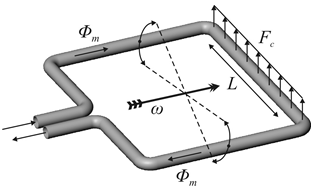Accurate mass flow sensing is of the utmost importance for a vast number of micro-fluidic applications, such as DNA or chemical analysis devices. Using a Coriolis force-based sensor, a number of problems can be overcome in comparison to other flow sensor devices. The main advantages of a Coriolis-based sensor are that it measures true mass flow, independent of the temperature, flow profile, density, viscosity, and homogeneity of the fluid.
The main principle of a Coriolis sensor can be seen in the figure below. If there is a mass flow in the given direction, the Coriolis force causes the U-shaped loop which is vibrated with a frequency ω to deform over the angle θc. The force (and hence the deformation) is directly proportional to the mass flow rate.

Figure 1: Operating principle of a Coriolis mass flow sensor.
REFERENCES
[1] J. Groenesteijn, R.G.P. Sanders, R.J. Wiegerink, J.C. Lötters, (2016) Towards nanogram per second Coriolis mass flow sensing. In: 29th IEEE International Conference on Micro Electro Mechanical Systems, MEMS 2016, 24-28 Jan 2016, Shanghai, China. pp. 193-196.
[2] J. Groenesteijn, R.J.A. Steenwelle, J.C. Lötters, R.J. Wiegerink, (2015) In-line picogram-resolution microchannel resonator for protein adsorption measurements operating at atmospheric pressure. In: 41st International Conference on Micro- and Nano-Engineering, MNE 2015, 21-24 Sep 2015, The Hague, The Netherlands.
